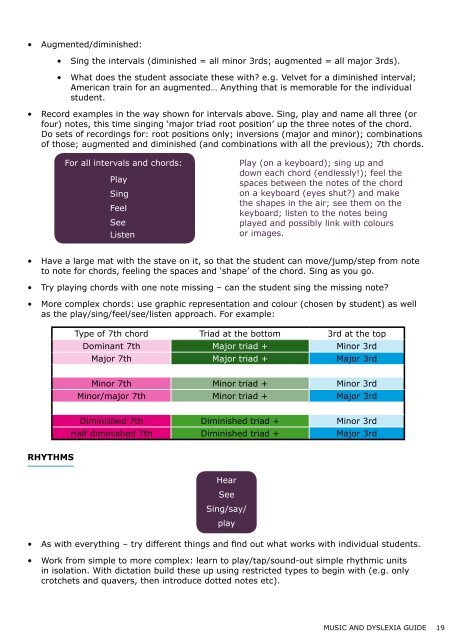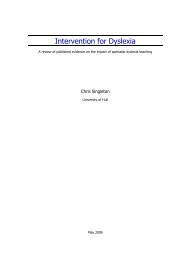TEACHER GUIDE TO MUSIC AND DYSLEXIA - Rhinegold Publishing
TEACHER GUIDE TO MUSIC AND DYSLEXIA - Rhinegold Publishing
TEACHER GUIDE TO MUSIC AND DYSLEXIA - Rhinegold Publishing
Create successful ePaper yourself
Turn your PDF publications into a flip-book with our unique Google optimized e-Paper software.
• Augmented/diminished:• Sing the intervals (diminished = all minor 3rds; augmented = all major 3rds).• What does the student associate these with? e.g. Velvet for a diminished interval;American train for an augmented… Anything that is memorable for the individualstudent.• Record examples in the way shown for intervals above. Sing, play and name all three (orfour) notes, this time singing ‘major triad root position’ up the three notes of the chord.Do sets of recordings for: root positions only; inversions (major and minor); combinationsof those; augmented and diminished (and combinations with all the previous); 7th chords.For all intervals and chords:PlaySingFeelSeeListenPlay (on a keyboard); sing up anddown each chord (endlessly!); feel thespaces between the notes of the chordon a keyboard (eyes shut?) and makethe shapes in the air; see them on thekeyboard; listen to the notes beingplayed and possibly link with coloursor images.• Have a large mat with the stave on it, so that the student can move/jump/step from noteto note for chords, feeling the spaces and ‘shape’ of the chord. Sing as you go.• Try playing chords with one note missing – can the student sing the missing note?• More complex chords: use graphic representation and colour (chosen by student) as wellas the play/sing/feel/see/listen approach. For example:Type of 7th chord Triad at the bottom 3rd at the topDominant 7th Major triad + Minor 3rdMajor 7th Major triad + Major 3rdMinor 7th Minor triad + Minor 3rdMinor/major 7th Minor triad + Major 3rdDiminished 7th Diminished triad + Minor 3rdHalf diminished 7th Diminished triad + Major 3rdRhythmsHearSeeSing/say/play• As with everything – try different things and find out what works with individual students.• Work from simple to more complex: learn to play/tap/sound-out simple rhythmic unitsin isolation. With dictation build these up using restricted types to begin with (e.g. onlycrotchets and quavers, then introduce dotted notes etc).<strong>MUSIC</strong> <strong>AND</strong> <strong>DYSLEXIA</strong> <strong>GUIDE</strong> 19









